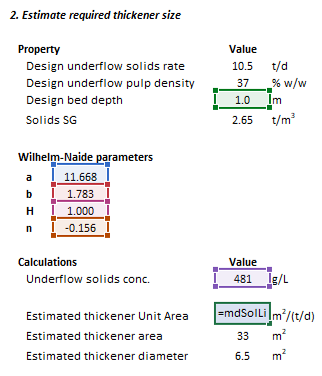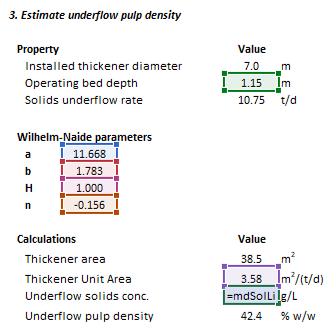Thickener (Wilhelm-Naide): Difference between revisions
Scott Munro (talk | contribs) m (1 revision imported) |
imported>Scott.Munro mNo edit summary |
||
| (4 intermediate revisions by 3 users not shown) | |||
| Line 2: | Line 2: | ||
This article describes a model for thickener sizing or underflow density estimation using the equations of '''Wilhelm and Naide''' (1981).{{Wilhelm and Naide (1981)}} | This article describes a model for thickener sizing or underflow density estimation using the equations of '''Wilhelm and Naide''' (1981).{{Wilhelm and Naide (1981)}} | ||
This model is not intended to replace more comprehensive thickener design and performance assessment methods and tools currently available. Rather, it is intended to provide the user with a comparatively simpler tool to quickly compare thickener sizes or estimate underflow pulp densities, in combination with other calculation tools or unit models. | |||
== Model theory == | == Model theory == | ||
{{Restricted content}} | |||
<hide> | |||
{{Under construction|section}} | {{Under construction|section}} | ||
</hide> | |||
== Excel == | == Excel == | ||
=== Unit area === | |||
The Wilhelm-Naide | The Wilhelm-Naide thickener unit area equation may be invoked from the Excel formula bar with the following function calls: | ||
<syntaxhighlight lang="vb">=mdSolLiq_Thickener_WilhelmNaide_UA(a as Double, b as Double, Cs as Double, Optional hHRatio as Double = 1, Optional n as Double = 1)</syntaxhighlight> | <syntaxhighlight lang="vb">=mdSolLiq_Thickener_WilhelmNaide_UA(a as Double, b as Double, Cs as Double, Optional hHRatio as Double = 1, Optional n as Double = 1)</syntaxhighlight> | ||
{{Excel (Text, Help, No Arguments)}} | |||
The input parameters and calculation results are defined below in matrix notation, along with an example image showing the selection of the same cells and arrays in the Excel interface: | |||
{| | |||
|- style="vertical-align:top;" | |||
| | |||
{| | |||
|- style="vertical-align:top;" | |||
|<math> | |||
\begin{align} | |||
a & = \big [ a \big ]\\ | |||
b & = \big [ b \big ]\\ | |||
\mathit{Cs} & = \big [ C_{\rm s}\text{ (g/L)} \big ]\\ | |||
\mathit{hHRatio} & = \begin{bmatrix} \dfrac{h}{H} \text{ (m/m)} \big ]\end{bmatrix}\\ | |||
n & = \big [ n \big ] | |||
\end{align}</math> | |||
|<math> | |||
\mathit{mdSolLiq\_Thickener\_WilhelmNaide\_UA} = | |||
\begin{bmatrix} | |||
{\rm UA}\text{ (m}^2\text{/(t/d))}\\ | |||
\end{bmatrix}</math> | |||
|- style="vertical-align:top;" | |||
|colspan="2"| | |||
where: | |||
* <math>a</math> and <math>b</math> are constants of the Wilhelm-Naide equation | |||
* <math>C_{\rm s}</math> is the concentration of solids in the thickener underflow (g/L.m<sup>2</sup> or t/m<sup>3</sup>) | |||
* <math>h</math> is the average depth of pulp in the test cylinder or operating thickener (m) | |||
* <math>H</math> is the expected full-scale or design compression zone depth (m) | |||
* <math>n</math> is the exponent of the pulp depth correction equation | |||
* <math>{\rm UA}</math> is the thickener unit area (m<sup>2</sup>/(t/d)) | |||
|} | |||
| | |||
:[[File:SolLiqWilhelmNaide1.png|frame|Figure 1. Example showing the selection of the input parameters (shaded blue, red, purple, green, pink and brown frames), and Results (green frame) array in Excel.]] | |||
|} | |||
=== Underflow solids concentration === | |||
The Wilhelm-Naide thickener underflow solids concentration equation may be invoked from the Excel formula bar with the following function calls: | |||
<syntaxhighlight lang="vb">=mdSolLiq_Thickener_WilhelmNaide_Cs(a as Double, b as Double, Ua as Double, Optional hHRatio as Double = 1, Optional n as Double = 1)</syntaxhighlight> | <syntaxhighlight lang="vb">=mdSolLiq_Thickener_WilhelmNaide_Cs(a as Double, b as Double, Ua as Double, Optional hHRatio as Double = 1, Optional n as Double = 1)</syntaxhighlight> | ||
{{Excel (Text, Help, No Arguments)}} | {{Excel (Text, Help, No Arguments)}} | ||
The input parameters and calculation results are defined below in matrix notation, along with an example image showing the selection of the same cells and arrays in the Excel interface: | |||
{| | |||
|- style="vertical-align:top;" | |||
| | |||
{| | |||
|- style="vertical-align:top;" | |||
|<math> | |||
\begin{align} | |||
a & = \big [ a \big ]\\ | |||
b & = \big [ b \big ]\\ | |||
{\rm UA} & = \big [ {\rm UA}\text{ (m}^2\text{/(t/d))} \big ]\\ | |||
\mathit{hHRatio} & = \begin{bmatrix} \dfrac{h}{H} \text{ (m/m)} \big ]\end{bmatrix}\\ | |||
n & = \big [ n \big ] | |||
\end{align}</math> | |||
|<math> | |||
\mathit{mdSolLiq\_Thickener\_WilhelmNaide\_Cs} = | |||
\begin{bmatrix} | |||
C_{\rm s}\text{ (g/L)}\\ | |||
\end{bmatrix}</math> | |||
|- style="vertical-align:top;" | |||
|colspan="2"| | |||
where: | |||
* <math>a</math> and <math>b</math> are constants of the Wilhelm-Naide equation | |||
* <math>{\rm UA}</math> is the thickener unit area (m<sup>2</sup>/(t/d)) | |||
* <math>h</math> is the average depth of pulp in the test cylinder or operating thickener (m) | |||
* <math>H</math> is the expected full-scale or design compression zone depth (m) | |||
* <math>n</math> is the exponent of the pulp depth correction equation | |||
* <math>C_{\rm s}</math> is the concentration of solids in the thickener underflow (g/L.m<sup>2</sup> or t/m<sup>3</sup>) | |||
|} | |||
| | |||
:[[File:SolLiqWilhelmNaide2.png|frame|Figure 1. Example showing the selection of the input parameters (shaded blue, red, purple, green, pink and brown frames), and Results (green frame) array in Excel.]] | |||
|} | |||
== SysCAD == | == SysCAD == | ||
| Line 26: | Line 106: | ||
[[Category:Excel]] | [[Category:Excel]] | ||
Latest revision as of 06:16, 15 July 2025
Description
This article describes a model for thickener sizing or underflow density estimation using the equations of Wilhelm and Naide (1981).[1]
This model is not intended to replace more comprehensive thickener design and performance assessment methods and tools currently available. Rather, it is intended to provide the user with a comparatively simpler tool to quickly compare thickener sizes or estimate underflow pulp densities, in combination with other calculation tools or unit models.
Model theory
Excel
Unit area
The Wilhelm-Naide thickener unit area equation may be invoked from the Excel formula bar with the following function calls:
=mdSolLiq_Thickener_WilhelmNaide_UA(a as Double, b as Double, Cs as Double, Optional hHRatio as Double = 1, Optional n as Double = 1)
Invoking the function with no arguments will print Help text associated with the model, including a link to this page.
The input parameters and calculation results are defined below in matrix notation, along with an example image showing the selection of the same cells and arrays in the Excel interface:
|
| ||||
Underflow solids concentration
The Wilhelm-Naide thickener underflow solids concentration equation may be invoked from the Excel formula bar with the following function calls:
=mdSolLiq_Thickener_WilhelmNaide_Cs(a as Double, b as Double, Ua as Double, Optional hHRatio as Double = 1, Optional n as Double = 1)
Invoking the function with no arguments will print Help text associated with the model, including a link to this page.
The input parameters and calculation results are defined below in matrix notation, along with an example image showing the selection of the same cells and arrays in the Excel interface:
|
| ||||
SysCAD
References
- ↑ Wilhelm, J. H. and Naide, Y., 1981. Sizing and operating continuous thickeners. Mining Engineering, 10(1981), p. 1710.

